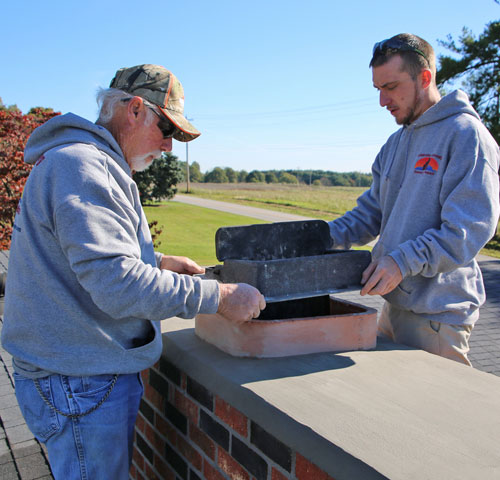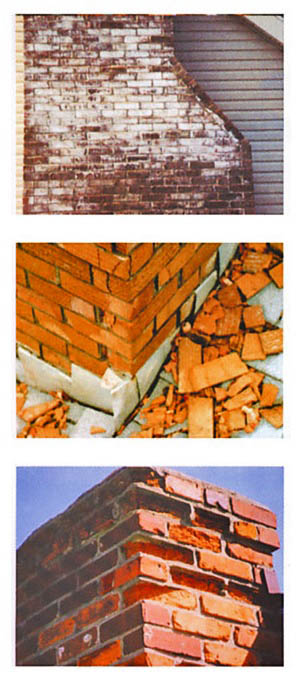Chimney Water Damage – Louisville
 Chimney water damage is a continuous threat, but homeowners often don’t realize it until a chimney is in need of extensive repairs. At Louisville Chimney Sweep & Repair, LLC, we frequently see chimney deterioration caused by moisture. To help avoid related costs of a deteriorating chimney, our recommendations are to schedule annual chimney inspections and learn how to identify signs of chimney water damage.
Chimney water damage is a continuous threat, but homeowners often don’t realize it until a chimney is in need of extensive repairs. At Louisville Chimney Sweep & Repair, LLC, we frequently see chimney deterioration caused by moisture. To help avoid related costs of a deteriorating chimney, our recommendations are to schedule annual chimney inspections and learn how to identify signs of chimney water damage.
How Does Water Cause Chimney Damage?
Masonry materials such as brick, mortar, concrete, flue tiles, and metals are all susceptible to damage caused by moisture. Bricks are very porous and can absorb moisture like a sponge. When water gets between the masonry, freezing and thawing cycles in winter cause the face of bricks to eventually pop off and break. Without needed repair to address the chimney water damage, the entire structure could begin to lean and eventually collapse. The following are more examples of damage caused by water in the chimney system:
- The flue lining deteriorates as a result of a mix of acidic creosote and moisture
- The interior and/or exterior of the chimney becomes stained
- Hearth support is weakened
- The wood and other supports adjacent to the fireplace begin to rot
- Firebox assemblies, dampers, and fireplace accessories such as glass doors rust and/or deteriorate
How Does Water Get into the Chimney System?
The causes of chimney water damage make it easy to see the importance of chimney maintenance and annual chimney inspections. If water intrusion is caught early, the damage it causes can be minimized, resulting in less expensive chimney repairs and maintenance. The following are some of the ways water enters the chimney system and causes damage:
- The chimney crown at the top of the chimney is supposed to act much like an umbrella. Eventually, the chimney crown deteriorates and cracks. This allows water to get into the space between the chimney flue and the exterior masonry. It can also allow water to flow down the walls of the chimney, which wears away at the mortar.
- The metal flashing on the chimney is supposed to provide a waterproof seal between the roof and the chimney. The flashing is prone to fail due to difficulty of proper installation, rusting, and more. The results of faulty flashing include a chimney leak that affects the structure of the roof and/or moisture in the masonry.
- Unless you have a chimney crown or a chimney chase top in a state of good repair, rain, sleet, and snow can flow directly into your chimney.
- If water runoff frequently inundates the chimney because it is located in a vulnerable position on a downhill slope of the roof, the chimney can prematurely deteriorate. A cricket can be built, to divert water away from the chimney. Crickets are deflectors, and they are often recommended on steep rooftops.
 Signs of Chimney Water Damage
Signs of Chimney Water Damage
Catching chimney water damage as early as possible helps to reduce repair costs. An annual chimney inspection by expert chimney technicians can help to ensure that unseen damage isn’t going undetected. The following are signs you could pick up on that might indicate the presence of moisture in your chimney system:
- White stains on your chimney.
- Cracked masonry on the interior or exterior of the chimney and/or fireplace.
- Musty odors, which is an indication there may be mold or mildew.
- Moist areas inside the firebox or chimney.
- Water stains in, on, or around the fireplace and/or chimney.
Contact Louisville KY Chimney Sweeps
Louisville Chimney Sweep & Repair is the best choice for chimney sweep repairs and services in Louisville KY. Contact us today at (502) 410-4019 if you see signs of chimney water damage or for any chimney services you may need.





 Tap to Call Now
Tap to Call Now